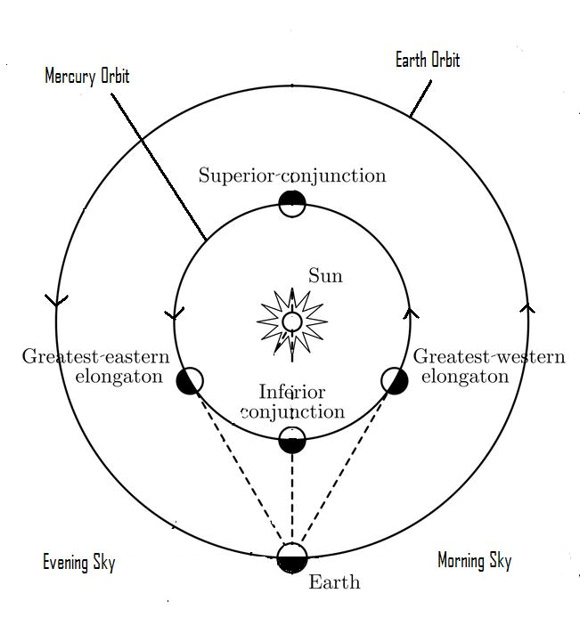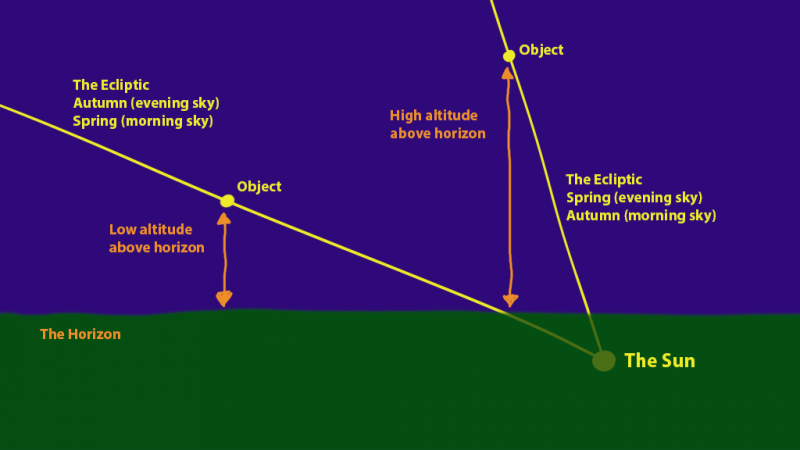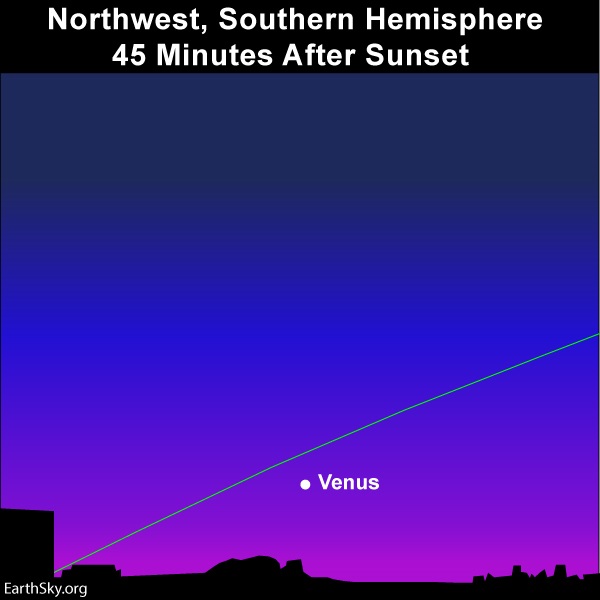
This week, the brightest planet – blazing Venus – reaches the end of its tether with respect to the sun. Its greatest elongation – farthest apparent distance from the sun in our sky – is March 24. This is Venus’ maximum elongation for the year 2020. The planet now resides a whopping 46.1 degrees east of the sun, placing Venus in the western sky after sunset. You can’t miss Venus after the sun goes down. It’s the brightest thing up there, and, later this week, the young moon will join the view. Who could ask for more?
But, wait there is more. At northerly latitudes, Venus – the “evening star” – stays out until late night. How cool is that?
Venus presents two greatest elongations in 2020, one in the evening sky and then one in the morning sky. Because Venus’ orbit is only slightly eccentric (oblong) – that is, it’s close to circular – the angular measure of Venus’ greatest elongations don’t vary much. They’re always at or close to 46 degrees.
Venus will reach its greatest elongation in the morning sky on August 13, 2020. Then it will be 45.8 degrees west of the sun, or in the eastern sky before dawn. Notice that, in 2020, the morning is slightly less than this week’s evening elongation:
2020 March 24: 46.1 degrees east of the sun (evening sky)
2020 August 13: 45.8 degrees west of the sun (morning sky)

An inferior planet – a planet that orbits the sun inside of Earth’s orbit – appears in the evening sky at its greatest eastern elongation, and in the morning sky at its greatest western elongation. The two inferior planets are Mercury and Venus, residing at a mean distance of 0.387 and 0.723 astronomical units from the sun, respectively.
Venus ranks as the third-brightest celestial body to light up the heavens, after the sun and moon. Some sharp-eyed people might even see this brilliant world in a daytime sky. However, most of us will have to wait until after the sun goes down to see this blazing beauty of a planet. Venus is the first “star” to pop out in the west after sunset.
Because Venus orbits the sun inside the Earth’s orbit, Venus can never be opposite the sun in our sky. Nor can Venus be as much as 90 degrees away from the sun in our sky (like the moon at its first and last quarter phases). At maximum, this world swings out 47 degrees from the sun on the sky’s dome. So, when Venus is visible, we either see it in the west after sunset or in the east before sunrise.

At sunset on the spring equinox, the ecliptic – pathway of the sun. moon and planets – hits the sunset horizon at its steepest angle of the year. But at sunset on the autumn equinox, the ecliptic hits the sunset horizon at its shallowest angle. Therefore, when Venus at its greatest evening elongation coincides closely with the spring equinox, Venus soars to its highest spot at sunset and stays out for a maximum time after sundown. Image via Dominick Ford.
Venus stays out for a maximum time after sunset when Venus’ greatest evening elongation coincides closely with the spring equinox. On the other hand, when a greatest evening elongation coincides with the autumn equinox, Venus’ presence in the evening sky, though not absent, is most subdued. Because the recent March 20 equinox counts as the Northern Hemisphere’s spring equinox yet the Southern Hemisphere’s autumn equinox, this evening apparition of Venus favors the Northern Hemisphere.
The farther north you live, the longer the time period for Venus staying out after sunset; and the farther south you live, the shorter. We give the approximate setting time for Venus at various latitudes:
60 degreees north latitude: Venus sets about 5 1/2 hours after sunset
40 degrees north latitude: Venus sets about 4 hours after sunset
Equator (0 degrees latitude): Venus sets less than 3 hours after sunset
40 degrees south latitude: Venus sets about 1 3/4 hours after sunsetWant more specific information? Click here for a sky almanac.
At sunset on and around the spring equinox, the ecliptic – the roadway of the planets on the sky’s dome – hits the sunset horizon at its steepest angle for the year. Therefore, Venus at its greatest evening elongation shines at its maximum altitude in the evening sky. Contrast the sky chart for about 40 degrees north latitude at top with the sky chart below at 40 degrees south latitude below.

On early autumn evenings, the ecliptic – pathway of planets – hits the horizon at a narrow angle at dusk/nightfall. It is now autumn in the Southern Hemisphere. See the sky chart at the top of this post for the Northern Hemisphere, where it is now early spring, showing the steep tilt of the ecliptic at dusk/nightfall.
At sunset on and around the autumn equinox, the ecliptic – the planetary roadway – hits the sunset horizon at its shallowest angle for the year. Therefore, Venus at its greatest elongation is much more subdued at southerly latitudes, although this brilliant world will nonetheless make a big splash at evening dusk.
From southerly latitudes, you have a much better view of Mercury at its greatest elongation in the morning sky. Far northerly latitudes probably won’t see Mercury at all.
Read more: Mercury’s greatest morning elongation on March 24
Bottom line: Venus swings out to its greatest elongation from the sun in the evening sky on March 24, 2020. At northerly latitudes, Venus stays out for a maximum time after sunset on these March 2020 evenings. Enjoy!
from EarthSky https://ift.tt/3dsPNqD

This week, the brightest planet – blazing Venus – reaches the end of its tether with respect to the sun. Its greatest elongation – farthest apparent distance from the sun in our sky – is March 24. This is Venus’ maximum elongation for the year 2020. The planet now resides a whopping 46.1 degrees east of the sun, placing Venus in the western sky after sunset. You can’t miss Venus after the sun goes down. It’s the brightest thing up there, and, later this week, the young moon will join the view. Who could ask for more?
But, wait there is more. At northerly latitudes, Venus – the “evening star” – stays out until late night. How cool is that?
Venus presents two greatest elongations in 2020, one in the evening sky and then one in the morning sky. Because Venus’ orbit is only slightly eccentric (oblong) – that is, it’s close to circular – the angular measure of Venus’ greatest elongations don’t vary much. They’re always at or close to 46 degrees.
Venus will reach its greatest elongation in the morning sky on August 13, 2020. Then it will be 45.8 degrees west of the sun, or in the eastern sky before dawn. Notice that, in 2020, the morning is slightly less than this week’s evening elongation:
2020 March 24: 46.1 degrees east of the sun (evening sky)
2020 August 13: 45.8 degrees west of the sun (morning sky)

An inferior planet – a planet that orbits the sun inside of Earth’s orbit – appears in the evening sky at its greatest eastern elongation, and in the morning sky at its greatest western elongation. The two inferior planets are Mercury and Venus, residing at a mean distance of 0.387 and 0.723 astronomical units from the sun, respectively.
Venus ranks as the third-brightest celestial body to light up the heavens, after the sun and moon. Some sharp-eyed people might even see this brilliant world in a daytime sky. However, most of us will have to wait until after the sun goes down to see this blazing beauty of a planet. Venus is the first “star” to pop out in the west after sunset.
Because Venus orbits the sun inside the Earth’s orbit, Venus can never be opposite the sun in our sky. Nor can Venus be as much as 90 degrees away from the sun in our sky (like the moon at its first and last quarter phases). At maximum, this world swings out 47 degrees from the sun on the sky’s dome. So, when Venus is visible, we either see it in the west after sunset or in the east before sunrise.

At sunset on the spring equinox, the ecliptic – pathway of the sun. moon and planets – hits the sunset horizon at its steepest angle of the year. But at sunset on the autumn equinox, the ecliptic hits the sunset horizon at its shallowest angle. Therefore, when Venus at its greatest evening elongation coincides closely with the spring equinox, Venus soars to its highest spot at sunset and stays out for a maximum time after sundown. Image via Dominick Ford.
Venus stays out for a maximum time after sunset when Venus’ greatest evening elongation coincides closely with the spring equinox. On the other hand, when a greatest evening elongation coincides with the autumn equinox, Venus’ presence in the evening sky, though not absent, is most subdued. Because the recent March 20 equinox counts as the Northern Hemisphere’s spring equinox yet the Southern Hemisphere’s autumn equinox, this evening apparition of Venus favors the Northern Hemisphere.
The farther north you live, the longer the time period for Venus staying out after sunset; and the farther south you live, the shorter. We give the approximate setting time for Venus at various latitudes:
60 degreees north latitude: Venus sets about 5 1/2 hours after sunset
40 degrees north latitude: Venus sets about 4 hours after sunset
Equator (0 degrees latitude): Venus sets less than 3 hours after sunset
40 degrees south latitude: Venus sets about 1 3/4 hours after sunsetWant more specific information? Click here for a sky almanac.
At sunset on and around the spring equinox, the ecliptic – the roadway of the planets on the sky’s dome – hits the sunset horizon at its steepest angle for the year. Therefore, Venus at its greatest evening elongation shines at its maximum altitude in the evening sky. Contrast the sky chart for about 40 degrees north latitude at top with the sky chart below at 40 degrees south latitude below.

On early autumn evenings, the ecliptic – pathway of planets – hits the horizon at a narrow angle at dusk/nightfall. It is now autumn in the Southern Hemisphere. See the sky chart at the top of this post for the Northern Hemisphere, where it is now early spring, showing the steep tilt of the ecliptic at dusk/nightfall.
At sunset on and around the autumn equinox, the ecliptic – the planetary roadway – hits the sunset horizon at its shallowest angle for the year. Therefore, Venus at its greatest elongation is much more subdued at southerly latitudes, although this brilliant world will nonetheless make a big splash at evening dusk.
From southerly latitudes, you have a much better view of Mercury at its greatest elongation in the morning sky. Far northerly latitudes probably won’t see Mercury at all.
Read more: Mercury’s greatest morning elongation on March 24
Bottom line: Venus swings out to its greatest elongation from the sun in the evening sky on March 24, 2020. At northerly latitudes, Venus stays out for a maximum time after sunset on these March 2020 evenings. Enjoy!
from EarthSky https://ift.tt/3dsPNqD

Aucun commentaire:
Enregistrer un commentaire